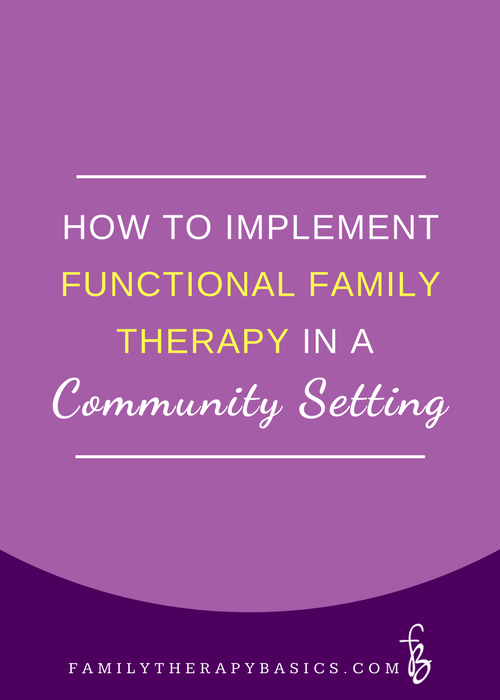Functional Family Therapy (FFT) is a common systemic approach for in-home family therapy. The October 2017 issue of the Journal of Marital and Family Therapy includes a research article titled, Barriers and Facilitators to Implementing Functional Family Therapy in a Community Setting, which offers information for practitioners on best practices for structuring FFT intervention. In this post, I summarize this latest research according to the article's main categories: a) referral and pre-intervention contact, b) engagement of families with the [FFT] intervention, c) structure and delivery format of FFT intervention, and d) organizational factors (McPherson, Kerr, Casey, & Marshall, 2017).
Referral Process and Pre-Intervention Contact
Educating referring agencies as well as clients on FFT in order to reduce skepticism, increase trust in the intervention, as well as motivate partnership and participation proved essential for overall client engagement. Client engagement also improved when feelings of pressure to participate in this specific modality were reduced. Feelings of pressure often occur when practitioners attempt to use the model without explaining their rationale for FFT, or its progression and expected outcomes.
The importance of the first visit
Study participants explained the importance of practitioners assessing the appropriateness of the family referral, as well as the family’s willingness to take part in FFT, during the initial session through a “non-authoritative and personable” approach (McPherson et al., 2017, p. 722).
“The findings from this study, alongside existing literature, highlight the need for future implementation of FFT to embed tailored pre-intervention engagement strategies designed to address barriers and facilitators of initial engagement. This should include building the knowledge and understanding of referring individuals (Zazzali et al., 2008) and identifying ways of supporting families to recognize their need for support” (p. 728).
Engagement of Families with the Intervention
The following qualities were essential for FFT practitioners, according to client families:
good listening skills
warmth
empathy
a desire to get to know the family
the ability to make people feel comfortable
non-judgment
These qualities allowed clients to develop trust in their FFT practitioner. One client explained the importance of “Being open about what you’re doing, why you’re doing it, . . . you know that there’s nothing that you’d be hiding from them . . . if there are risks you would inform them” (p. 723).
Further, FFT practitioners described patience and persistence, through “maintaining drive, energy and momentum” as essential when families were not fully engaged in FFT. In addition, continued nonjudgemental interaction with the family, while providing an ongoing rationale for FFT intervention were helpful in re-engaging families.
Additional factors that improved engagement included when family members:
recognized their problems
were motivated for change
experienced positive changes as a result of FFT
understood FFT and its potential benefits
had a positive view of previous involvement with support services
received encouragement from family and friends
The opposite of these factors reduced family engagement, and therefore, treatment outcomes.
Structure and Delivery Format of FFT Intervention
FFT's structure and treatment elements were mainly seen as facilitators of implementation and client engagement by study participants. For example, practitioners and families appreciated FFT due its ability to be tailored to each specific family’s needs, as well as the option to use interactive and creative interventions. Both families and practitioners viewed FFT's home-based context as a factor that increased family participation.
Organizational Factors
Organizational factors in implementing FFT refer to practitioners' perspectives on the modality, training, teamwork, and supervision.
Therapist factors
“There was a view that implementation was enhanced when practitioners had exiting qualifications or training that were compatible with FFT and when they had a belief in the effectiveness of the model" (p. 726).
Practitioners viewed the following factors as barriers to or facilitators for implementing FFT:
whether or not FFT was a good fit for the practitioner
having a team leader that had treatment experience with FFT along with an understanding of and belief in the modality
a supportive team culture in general, involving open communicaiton with colleagues, teamwork, supervision, as well as a process for contrusctive feedback (p. 726).
Practitioners emphasized the need for ongoing training after initial FFT training, as well as supervision focused on competency building rather than evaluating performance (p. 727).
Workload issues, such as documenting and recording work with families, case management tasks, and large caseloads were said to take away from FFT implementation (i.e., direct contact with families).
Summary
McPherson, Kerr, Casey, and Marshall's study (2017) offers therapists working in community settings, utilizing FFT, research-based ideas for how to implement FFT in ways that will enhance engagement on the part of clients. Factors related to referring agencies and support services, explanation of treatment, and therapist interaction influence clients' perceptions of practitioners and FFT, as well as their sense of ownership of and belief in change. Organizational factors, including supervision, collaboration, and team culture create an environment where practitioners are able to influence positive views of FFT interventions by family members, whether they are fully engaged or distanced from treatment. These factors, taken together, provide a roadmap for therapists and supervisors using FFT in their work.
Let's Chat
What one thing was most helpful about this article?
What one thing from this research will help increase engagement in your FFT work?













